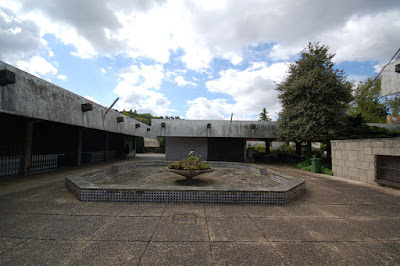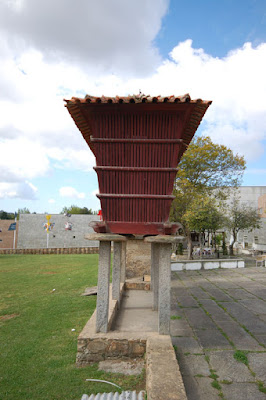On the way to Arouca Paulo took a small diversion thru Santa Maria da Feira to show me the Vila da Feira Municipal Market designed by Fernando Távora.

.jpg)
.jpg)
This is one of the key works for the revision of the modern movement in the CIAM, forcing a change on the key focus in architecture. Távora's architecture springs from his questioning of modernity, he sought to integrate local and traditional values and this was a key project for him in this quest.
.jpg)
.jpg) This is also one of the first projects where Alvaro Siza is involved in. Though he was only a young architect in Távora's office he was quiet involved in this building and was solely responsible for certain aspects of it – the most clearly visible of these are the colourful mosaics he designed in the flooring which were used as signage for the various wings of the market.
This is also one of the first projects where Alvaro Siza is involved in. Though he was only a young architect in Távora's office he was quiet involved in this building and was solely responsible for certain aspects of it – the most clearly visible of these are the colourful mosaics he designed in the flooring which were used as signage for the various wings of the market. .jpg) Now to Arouca - it is a beautiful little town set in a stunning landscape; surround by mountains which in this season is mostly covered in flowers.
Now to Arouca - it is a beautiful little town set in a stunning landscape; surround by mountains which in this season is mostly covered in flowers.The town is a popular destination for Portuguese tourist because of its famous Monastery. In fact the history of Arouca is directly connected to the history of its Monastery.
.jpg) It was around the Monastery that for many centuries the people from Arouca worked, lived, prayed and enjoyed their free time.
It was around the Monastery that for many centuries the people from Arouca worked, lived, prayed and enjoyed their free time..jpg)
.jpg)
Arouca is also famous for its sweets and pastry, with a big conventual influence. In fact, made by the nuns of the Arouca Convent, the sweets were considered to be the great highlight of the Convent.

But the one thing I was most looking forward to seeing here was this small private house. It was designed by my friend Paulo and though it’s his first project it’s amazingly well designed!

.jpg) Another interesting thing I saw here is the traditional espigueiros which are basically grain storage containers raised on pilotis with round caps to keep rats at bay.
Another interesting thing I saw here is the traditional espigueiros which are basically grain storage containers raised on pilotis with round caps to keep rats at bay..jpg)
.jpg)

No comments:
Post a Comment